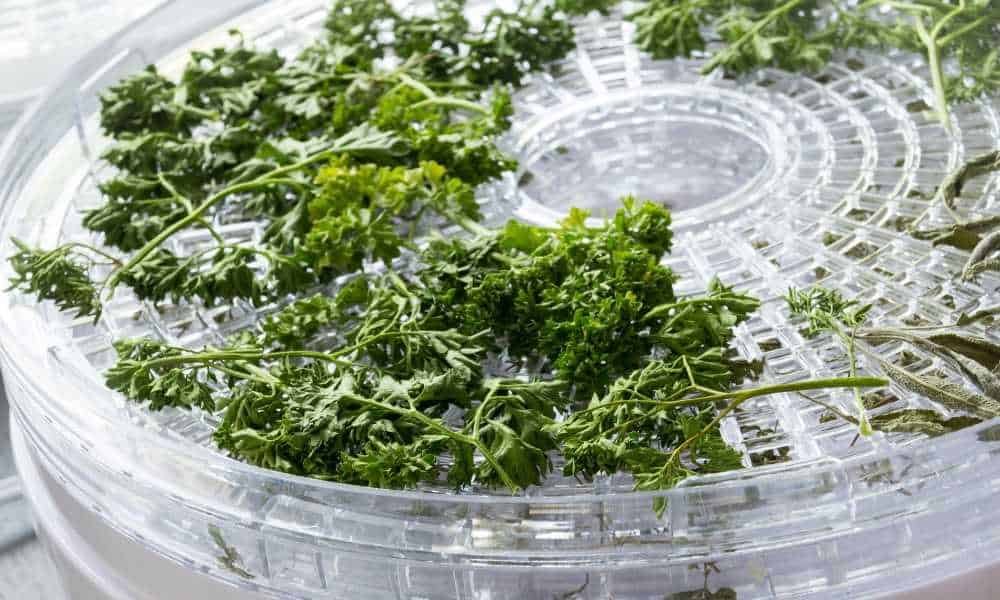If you need to dehydrate herbs and want to have them last as long as possible, you ought to consider getting yourself a dehydrating machine. The machine uses heating to remove the moisture from your fruits, vegetables, and meats. It is almost Christmas and if you have no idea what to get your health-conscious or vegetarian friend, then you ought to consider getting them the best food dehydrator for herbs.
| Product Image | Product Name / Primary Rating / Price | Primary Button |
|---|---|---|
|
||
|
||
|
Herbs are best known for their flavorful and aromatic contributions to recipes. Still, they also have a long history of helping treat many health conditions. As a result, people have grown more plants at home to dry out and preserve them. Dried herbs can be used in various cooking recipes, but they can also be used to make tea, either by blending it with other dried herbs or by steeping the leaves on their own.
To look for the best dehydrator for herbs, users will need to look for one that has temperature control. It should also have enough trays to dry your food. Finally, look for one that has a transparent window in the door to allow you to look in and check on the food.
Elite Gourmet EFD319 Food Dehydrator
It is easy to use this dehydrator to dry your food as there is an easy selector knob for all your functions. Even though it may take a while, the dehydrator will provide you with nice dried-out herbs for easy use and longer storage options.
Pros
- It has low energy consumption. It uses only around 350 watts of power to operate, making it an economical device for your food dehydration.
- You have up to 5 trays for more space. With so many trays, you can dry a large batch of herbs and other foodstuffs in one session.
Cons
- The trays are not made from food-safe stainless steel materials. With the trays made from plastic, you are not sure how long they will last before they break.
- Dehydrating food in this appliance takes a long time. For some, it may be convenient if it takes longer, but most people would want their dehydrator to take no longer than one day.
Food Dehydrator Machine From Cusimax
This device is ideal for drying herbs, but you can also dry various other food types such as meat and fruit. The 360-degree rotation of the shelves ensures that all your food is dried out evenly.
You can change the distance between the shelves to make space for larger pieces of foods you want to dry.
Pros
- All the trays are dishwasher safe. You can easily clean the parts of the device in the dishwasher to save you time and effort.
- It is easy to clean the interior. This adds to the convenience where you can clean the inside with a damp cloth and a quick wipe down.
Cons
- It does not operate at the highest temperatures. It is found that this appliance will run at a maximum of 135 degrees instead of 158 degrees.
- No fruit roll-up tray is included. This means that you will have to buy one separately at an extra cost if you want to make dried fruit rolls.
Colzer Food Dehydrator machine
A clear glass door makes it easy to keep an eye on the food inside without opening the front door of the device. You have a built-in timer that will go off after the selected time you chose to hydrate the food in it.
You have four silicone sheets to dry small pieces of food on the trays without falling through the grid.
Pros
- You have lots of space for food dehydration. With up to 8 trays to fill up and the large interior, you can do everything in one go.
- It has a quick drying time. In only 24 hours, you can dry a whole batch of herbs and fruits or other food types.
Cons
- The dehydrator is noisy when in use. While running it, this appliance vibrates a lot, and some people may find the sound irritating after a few hours.
- It gets hot on the outside. With very little insulation, the metal frame of this appliance gets too hot to touch with bare hands.
Cuisinart DHR-20 Food Dehydrator
With the added fruit roll-up sheet, you can easily make your own dried fruit rolls at a fraction of the cost. The top venting system provides an even distribution of airflow for quick and easy fruit and herb drying.
It is made of compact and lightweight construction, so it will be easy to store when not in use.
Pros
- You have a quick hydrating time. You will be able to dry your herbs and even meat in as little as 8 hours and at most 12 hours.
- The fan can be used on its own. This may take a bit longer, but wind-dried food may taste better and save some energy.
Cons
- Difficult to align the trays. If the trays are not perfectly aligned, the appliance will not work properly for dehydrating your food.
- High energy consumption. With an operation wattage of 620 watts, this device will consume a lot of energy when operating.
Homdox Food Dehydrator
This upgraded version has a fine mesh sheet added to it for easy drying of even the smallest pieces of food. The precise time allows a range of time increments from only one hour and up to 72 hours and 30 minutes increments.
Optimum drying is achieved without rotating the trays with the strong fan and heating element at the bottom.
Pros
- You have up to 8 trays at your disposal. This means that you can dry a large batch of herbs and other foods in one session.
- This machine is quiet. With a low noise operation, this food dehydrator can run in the background and will not annoy you.
Cons
- The soft plastic interior may melt if overheated. This may cause the smell of the melting plastic to be absorbed in your dried food.
- It does not have a high maximum heating option. At only 158 degrees, this device may take a bit longer to dehydrate your food to be perfectly dry.
FAQs
How can you use a food dehydrator to dry herbs?
To use a food dehydrator to dry herbs, spread the herbs in an even layer on the dehydrator’s trays and set it to its lowest temperature. Allow them to dry for several hours until they are completely crisp.
What are the benefits of drying herbs in a food dehydrator?
The benefits of drying herbs in a food dehydrator include preserving their flavor and aroma and extending their shelf life significantly longer than fresh or dried store-bought varieties.
How do you store dried herbs?
Dried herbs should be stored away from heat and light sources, such as inside airtight containers or jars with tight lids in cool dark places like pantries or cupboards, away from direct sunlight exposure.
What are some of the best herbs to dry in a food dehydrator?
Some of the best herbs for drying using a food dehydrator are thyme, oregano, basil, rosemary, sage lavender, chamomile mint dill marjoram, parsley bay leaves, cilantro tarragon, etc…
The Verdict
Cooking with herbs adds an amazing depth of flavor to your meals, but they can be quite pricey. Investing in one of the food dehydrators above will allow you to create your own herbs, and make mixes that you enjoy. Plus, you can use the dehydrator for fruits and veggies too.
Our favorite of the above options is the Colzer Food Dehydrator Machine, thanks to the space it offers and the fast drying time. This is one of the best food dehydrator for drying herbs. But the choice is yours based on your budget and preferences. Happy drying!






